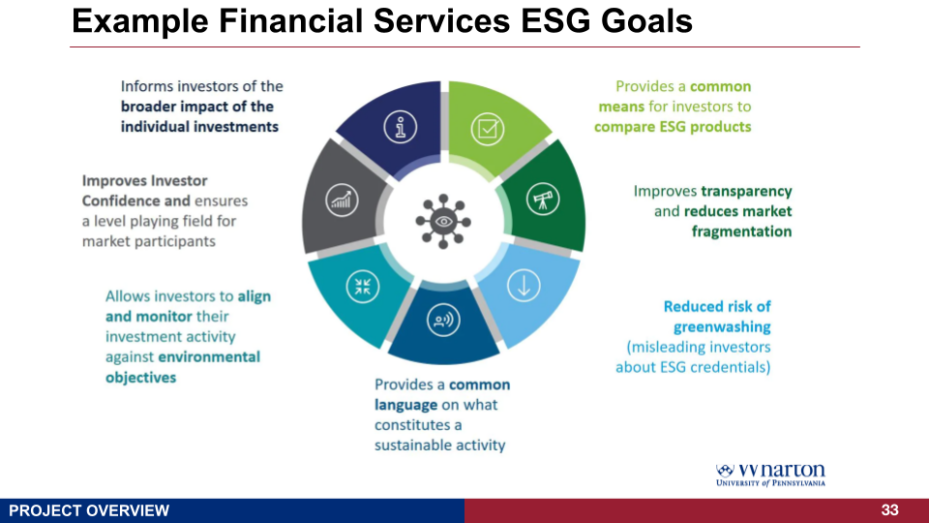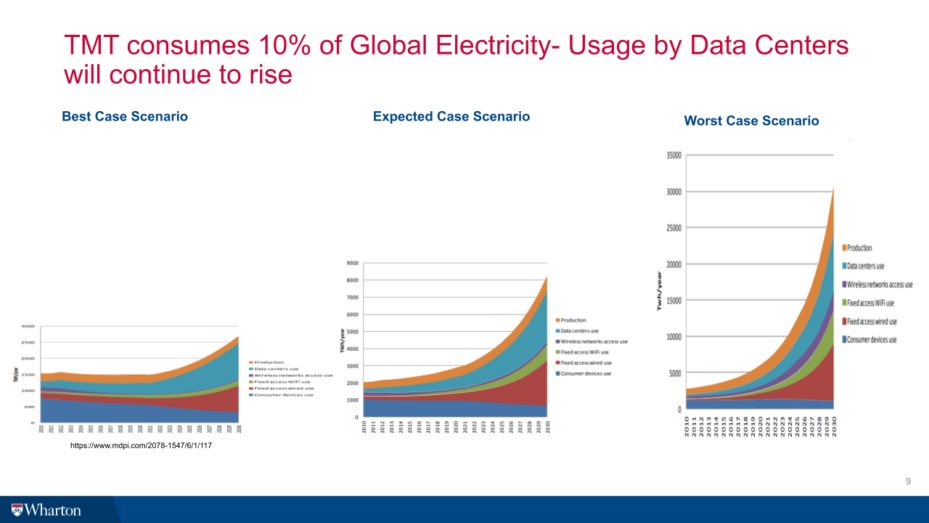Each semester, the Mack Institute’s Collaborative Innovation Program (CIP) brings Wharton and Penn students into some of the world’s top companies to solve organizational challenges. This past semester (Fall 2021), students consulted on a diverse lineup of live business challenges in industries ranging from metalworking to green banking.
The projects offer a window into the biggest trends, opportunities, and potential pitfalls in business strategy and innovation management. Below, we’ve rounded up some of the most interesting insights and key takeaways from our student consultants’ projects. Centered around some of the Mack Institute’s primary research areas, we’ve selected projects that relate to the following themes:
- Embracing New and Emerging Technologies
- Environment, Sustainability, and Governance
- New Players and Expanding Ecosystems
Part of a three part series
Theme 2: Environment, Sustainability, and Governance
Case Study C: Implementing Green/ESG Foundation into a Platform Strategy
Sustainability is one of today’s most pressing issues, and many firms participate in CIP with the goal of creating a greener business model. In one Fall 21 project, a CIP team worked with a major bank to incorporate ESG foundations into their platform strategy. The CIP team analyzed the successes of competitor banks, identified areas of expansions and potential pitfalls, and also developed a model for incorporating local carbon offset programs into the platform.
Excerpt from report:
Global Organizations in banking and asset management are setting the ESG backdrop worldwide. With this, under the Biden administration’s “US Net Zero 2030” initiative, the US public sector has established a strong foothold for ESG support. We would like to focus further on how the largest US banks execute on this ESG grand vision, and facilitate their historical capital commitment to finance ESG strategic projects coast to coast. UN leads the way globally as 95 banks across 30 countries join forces under its Net- Zero Banking Alliance, combining $66 Trillion in AUM. Net Zero Asset Managers Initiative follows closely by combining $57 Trillion in AUM from 220 asset managers as signatories internationally. Ceres plays a key role in the US, focusing on major ESG initiatives across major industries.
These have accelerated the US public sector, from the White House to regional governments, to make their ESG push. California Cap-and-Trade has been well integrated with many local businesses looking to become carbon neutral, with the added Carbon Offsets, to position California at the forefront of ESG push. East-Coast regional governments also put themselves on the ESG map with 9 states joining forces under RGGI.
Zooming in on major banks in the US, while Bank of America has claimed Scope-1 Carbon Neutral in 2019, major US financial firms have pledged major capital- facilitation commitment toward ESG projects in both Public and Private sectors.
Some of the Areas of Focus can be seen in the following:
-
- Green, Social and Blue bond issuances
- Establish and fund in-house climate-innovation and sustainability investing arms Direct financing of ESG strategic projects for private-sector (both privately- held and publicly-traded corporate clients) in Oil, Energy, Auto and Transportation sectors
- Wealth Management (multi-generational wealth) and Real Estate related client segments

Case Study D: The Impact and Role of Climate Change and the Race to Net Zero in the Technology Industry
Another ESG project from the Fall 2021 cohort paired students with a global risk management firm specializing in providing insights for digital infrastructure providers and telecom companies. The aim of this project was to explore the strategic roles, responsibilities, and opportunities of tech companies, customers, insurers, investors, and regulators in addressing system-wide climate risks. Their project dug into both the macro-level forces impacting climate risk, providing ten case studies from ten leading Technology, Media, and Telecommunications (TMT) companies.
Excerpt from report:
We identified the TMT drivers contributing to climate change and divided them into three categories: increased energy demand, technology redundancy, and direct environmental impact. We then dug down deeper into which are causing the most significant impact. From the research, it became apparent that the top 5 drivers are as follows:
Energy consumption at data centers: TMT consumes 10% of global electricity, and usage by data centers will continue to rise. Most data centers don’t have plans to use renewable energy, and the ones using it are through Power Purchase Agreements (PPAs) and not a direct investment.
Renewable energy usage % published by tech companies: Even though all big techs claim to be running 100% on renewable energy, are they changing the system to reach this goal, or is it just through renewable energy certificates (RECs_and PPAs?
Replacement v/s Repair: Technology companies are already feeling pressure from the public and government to make more durable products and release the monopoly on product repairs
Carbon footprints of the supply chain: Carbon is a new currency. More accurate, granular, and timely emission transparency is required to run the business in the future.
Use of digital technology by consumers: GHG emissions from the use of technology are significant, and these scope three emissions will have to be considered by the technology industry in their net-zero pledges.

We also identified some of the challenges the tech industry is facing to get to net-zero value chains and how they’re mitigating their contributions to climate change. in front of the technology industry to get to net-zero value chains. The broader focus in this section was in three main categories:
Addressing increased energy demand: As technology firms are growing at a rapid pace, the increase in energy demand is being addressed mainly by the purchase of renewable energy contracts (RECs). In 2020, Amazon made a huge leap in the amount of RECs purchased to address their energy requirements and also accomplish their goal of powering all their operations with 100% renewable energy by 2025. In addition, efficiency improvements are being made through new technological advancements in the telecom industry (5G technology) and innovative efficiency gains in cloud services.
Addressing e-waste and circular economy: Hardware companies like Apple are focusing on improving the recycling rates of the materials used in their products. By making an assessment of the highest impact materials in their products, Apple was able to address the biggest contributors to their carbon footprint and was able to recycle a big % of the metals that require energy intensive mining. Partnerships like the Circular Electronics Partnership (CEP)are also trying to establish a framework for circular design which encourages recycling and reuse.
Building Resilience: Firms are building resilience by being open and transparent about the climate change impact on their short and long term finances. Verizon started adopting reporting strategies from the Task Force on Climate-Related Financial Disclosures (TCFD) in 2019 by providing investors and customers with information regarding steps they are taking to address the climate change challenges. By being open and transparent, companies can avoid green swan events and reduce market volatility. TCFD reporting is a step in the right direction, but the lack of clear guidelines make it difficult to compare different firms. European taxonomy is expected to help standardize the terminologies and understand what it truly means to be a sustainable company in the near future.
To learn more about the Mack Institute’s Collaborative Innovation Program and read interviews with alums from the program, click here.



